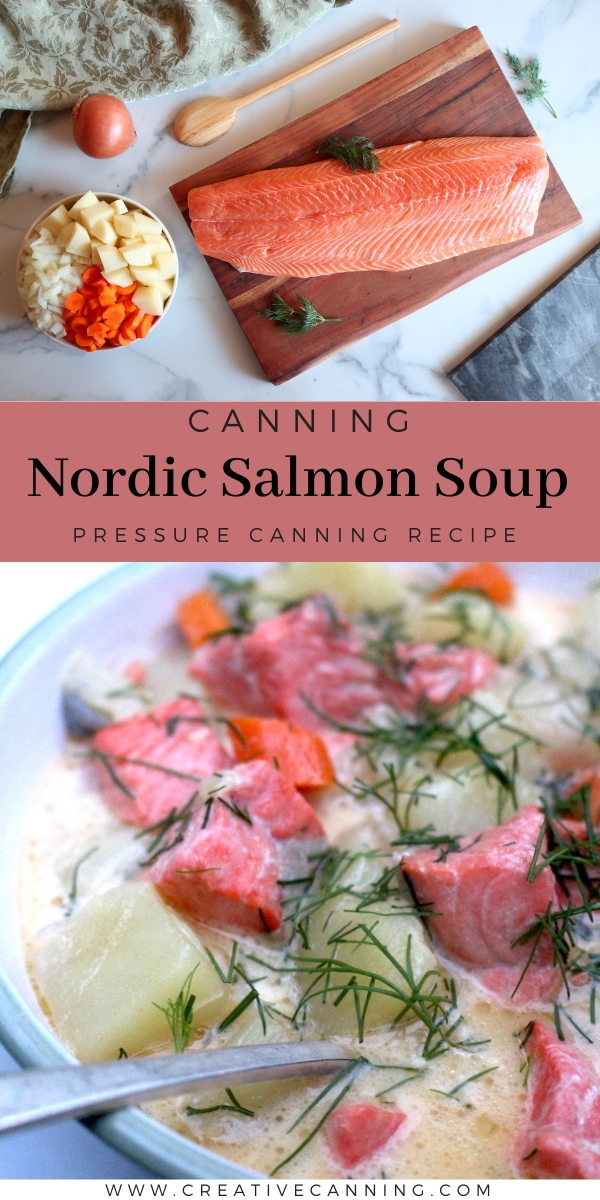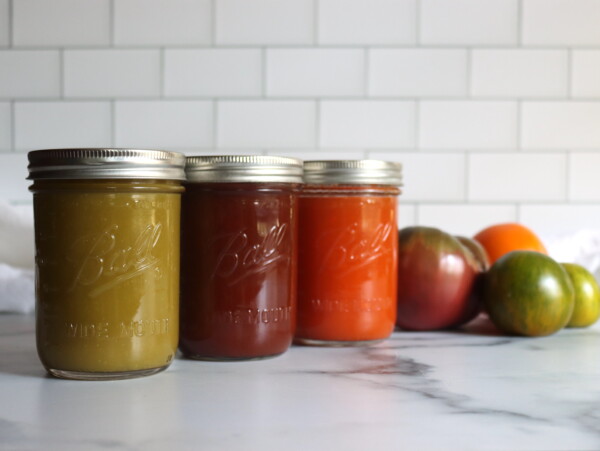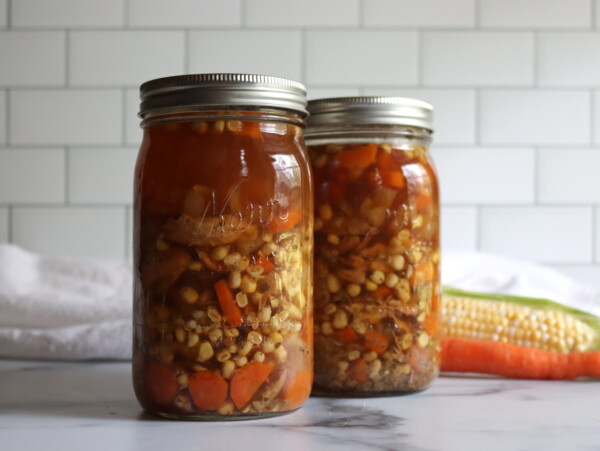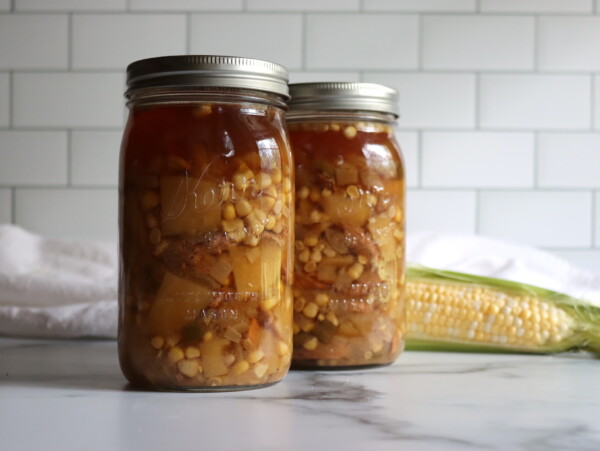This post may contain affiliate links. Please see our disclosure policy.
Nordic salmon soup is a traditional Scandinavian recipe, and it’s easy to make ahead for pressure canning.
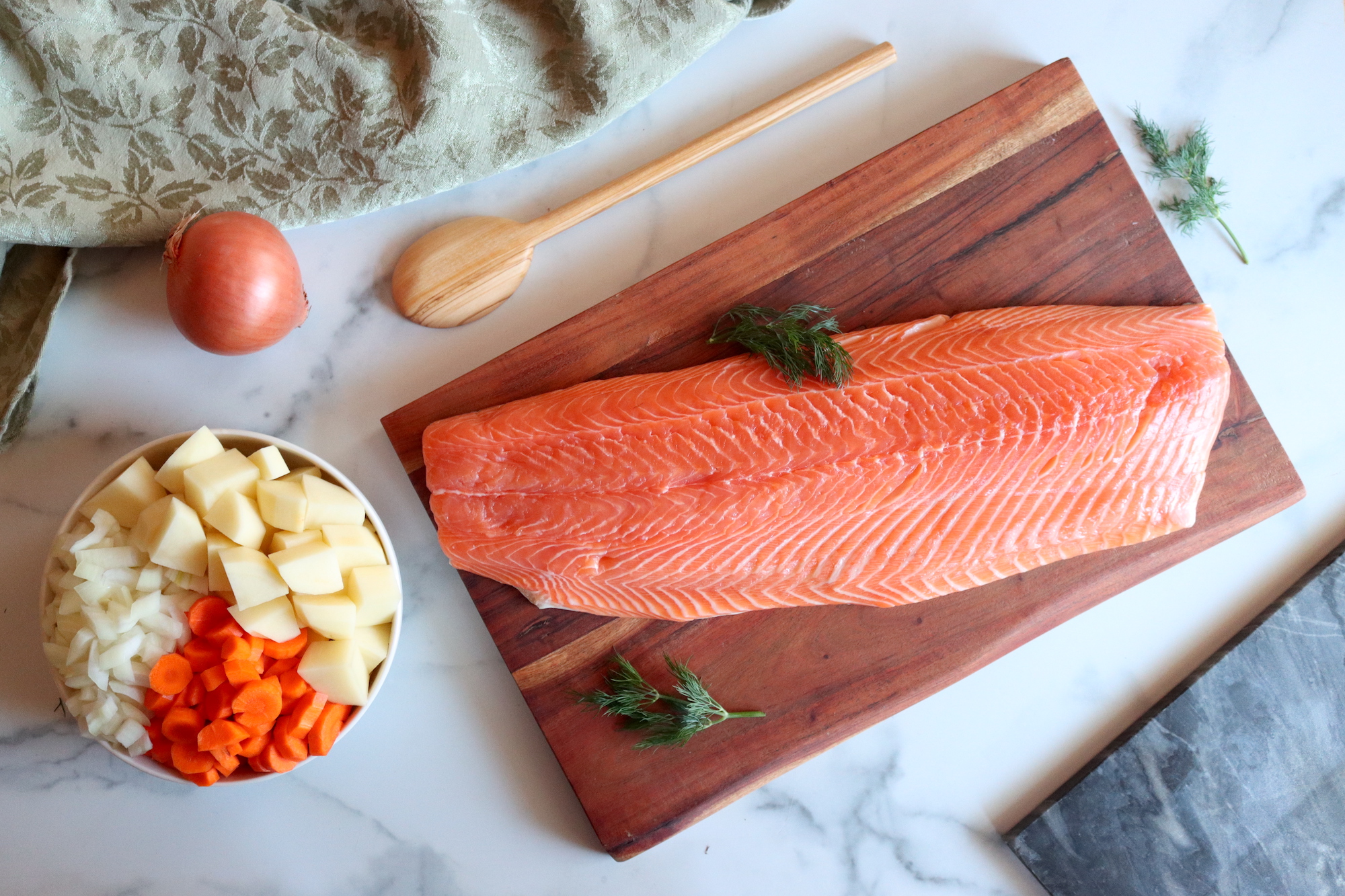
This hearty soup features tender pieces of salmon, potatoes, carrots, onions, and a flavorful broth. It’s a staple comfort food, particularly in the cold Nordic winters.
The creamy broth, savory salmon, and tender vegetables create a symphony of flavors that dance on your palate. It’s a dish that warms both the body and soul, perfect for sharing with family and friends. Plus, it’s packed with nutrients, making it a healthy choice for those mindful of their diet.
While Lohikeitto is most commonly associated with Finland, other Nordic countries have their own versions of this delightful soup. In Norway, it’s known as laksesuppe, often enhanced with fennel, tomatoes, and spices like basil and paprika.
The Danish version, also called laksesuppe, might include celery, cabbage, and a hint of curry powder for an extra kick. In Sweden, laxsoppa sometimes features greens like spinach and is thickened with egg yolks and flour for a creamier texture.
This guide will walk you through everything you need to know about canning this delightful dish.
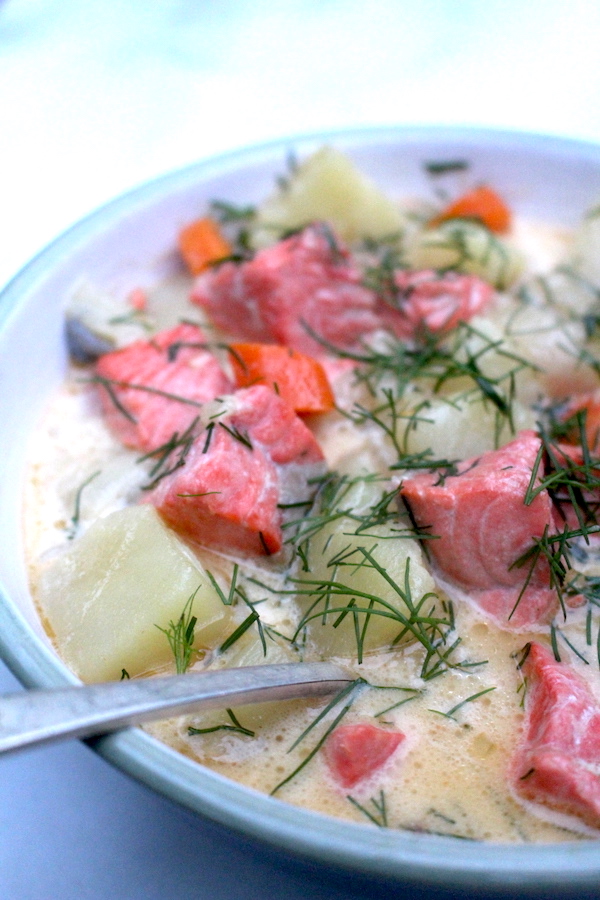
Ingredients for Nordic Salmon Soup
This recipe is based on the University of Alaska’s Hearty Soup canning protocol. That guidance allows you to create your own soup canning recipe, provided you use their specific guidelines, times, and pressures. The ingredients for canning Nordic salmon soup are quite simple. To make a canner batch of eight pints, you’ll need the following:
- 1.5 lbs salmon
- 2.5 lbs potatoes (about 7 cups peeled and chopped)
- 1 lb carrots (3 cups chopped)
- 1 large onion (about 10 oz, or 2 cups chopped)
- 2 quarts broth (fish stock, chicken broth, or vegetable broth)
- 4 tsp salt
- 1 tbsp fresh dill
You can replace some of the broth with a dry white wine if you like, and that’s a nice addition to this home canned soup.
This soup is can be eaten as is, or used as a base. You can’t add cream, egg yolks or cabbage to the recipe before canning, but you can add them when serving to give you a more regionally specific nordic chowder.
If you’re feeling adventurous and want to try the Norwegian version, add diced fennel and tomatoes. For the Danish twist, include celery, cabbage, and a dash of curry powder. And if you’re leaning towards the Swedish style, don’t forget the spinach and a bit of flour and egg yolks for that creamy finish!
Personally, I like it simple, and I serve this soup warmed and then topped with a splash of cream and maybe a bit of fresh dill.
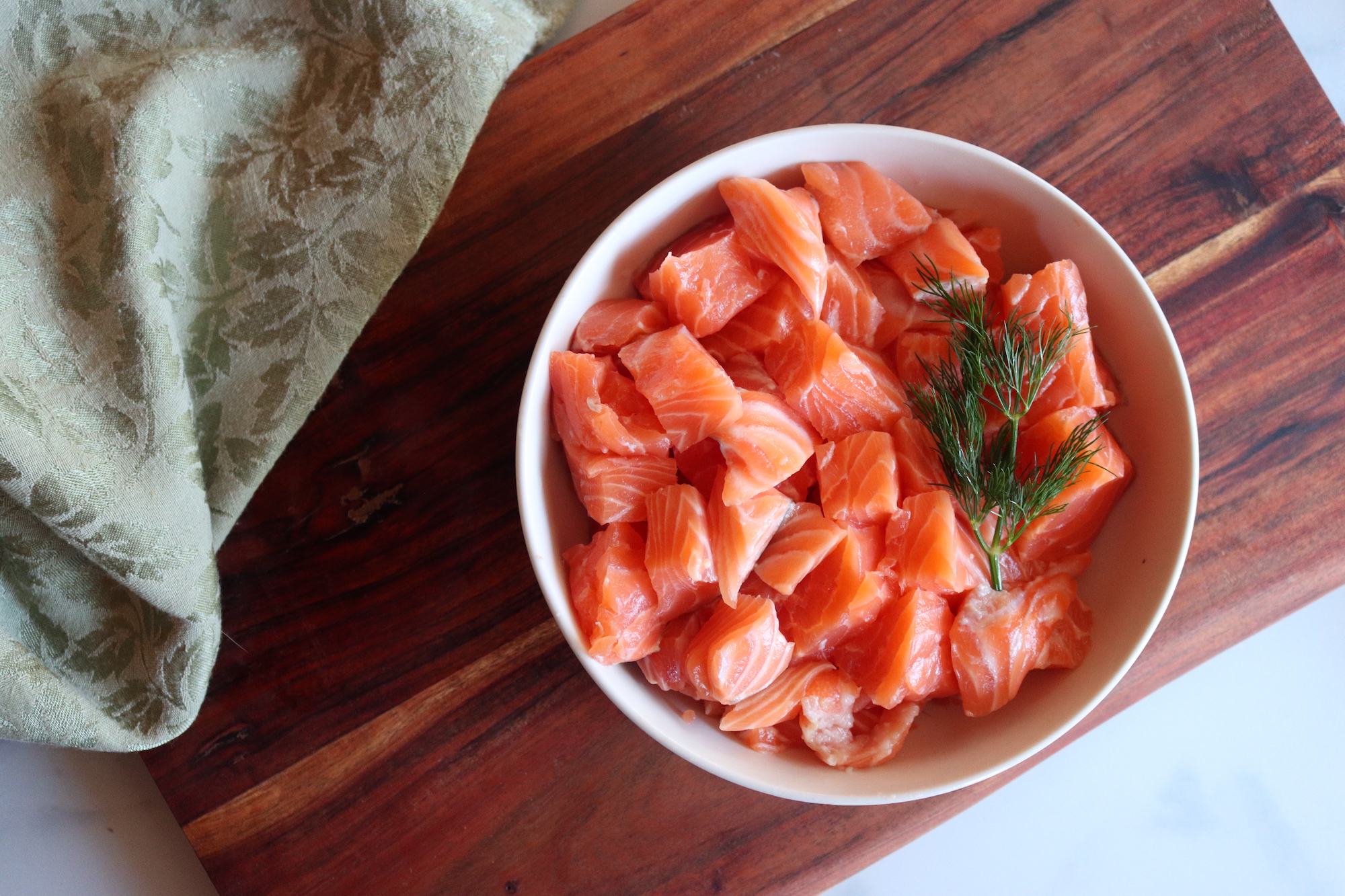
Canning Nordic Salmon Soup
Before you start canning, you’ll need to prepare your ingredients.
First, make sure you’re using fresh, wild-caught salmon if possible. It makes a significant difference in flavor and quality. Cut the salmon into bite-sized pieces, leaving some bones in if you like – they will soften during the canning process.
Next, chop your potatoes, carrots, and onions. Combine all your ingredients in a large pan and cover with hot water, broth, or wine. Boil for five minutes to meld the flavors together. Add the salt, herbs, and spices to taste, but remember to be conservative – the flavors tend to intensify during canning.
Make sure your canning jars are hot and clean. Fill each jar with the soup mixture, leaving one inch of headspace at the top. Wipe the rims to remove any food particles, then add water to your pressure canner and turn on the heat.
Vent steam for 10 minutes, then add your weight. Process pints for 100 minutes at 11 lbs pressure in a dial gauge canner or 10 lbs pressure in a weighted gauge canner. Be sure to adjust the pressure to altutude.
Once processed, turn off the heat and let the canner depressurize on its own. Once the pressure has returned to zero, wait a few more minutes, then remove the lid and the jars.
Allow the jars to cool for 24 hours at room temperature, then check the seals, label, and store them in a cool, dark place. Properly canned, your Nordic salmon soup will be ready to enjoy for months to come.
Altitude Adjustments
With pressure canning, the processing times stay the same at higher altitudes, but the pressures change. Here are the altitude adjustments for pressure canning Nordic Salmon Soup:
For dial gauge pressure canners:
- 0 to 2,000 feet in elevation – 11 lbs pressure
- 2,001 to 4,000 feet in elevation – 12 lbs pressure
- 4,001 to 6,000 feet in elevation – 13 lbs pressure
- 6,001 to 8,000 feet in elevation – 14 lbs pressure
For weighted gauge pressure canners:
- 0 to 1,000 feet in elevation – 10 lbs pressure
- Above 1,000 feet – 15 lbs pressure
Serving Nordic Salmon Soup
When it’s time to enjoy your canned Nordic salmon soup, simply heat and eat. The rich, flavorful broth and tender salmon pieces make it a satisfying meal on its own.
However, you can elevate it even further by adding a splash of cream or a handful of fresh dill just before serving. Here are a few ideas of how you can best serve it (but feel free to get creative!):
- Fresh Rye Bread: Serve with a side of hearty, freshly-baked rye bread.
- Smoked Salmon Salad: Pair with a light salad featuring smoked salmon, mixed greens, and a tangy mustard dressing.
- Pickled Vegetables: Add a side of pickled beets and cucumbers to enhance the meal’s Nordic flavors.
- Cheese and Crackers: Offer an assortment of Nordic cheeses such as Jarlsberg or Västerbotten, paired with crisp crackers.
- Herbed Butter: Create a flavored butter with fresh dill and lemon zest to spread on bread or crackers.
- Apple Cider: Complement the soup with a glass of chilled apple cider, bringing an additional layer of flavor contrast.
- Potato Pancakes: Crispy potato pancakes with a dollop of sour cream or crème fraîche match wonderfully with the rich soup.
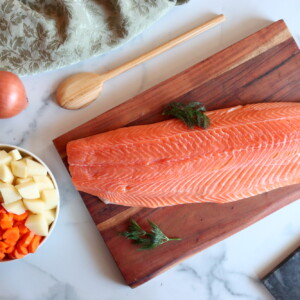
Canning Nordic Salmon Soup
Equipment
Ingredients
- 1.5 lbs salmon
- 2.5 lbs potatoes, about 7 cups chopped
- 1 lb carrots, 3 cups chopped
- 1 large onion, about 10 oz, or 2 cups chopped
- 2 Quarts stock
- 4 tsp salt
- 1 tbsp fresh dill, optional
Instructions
- Cut salmon into bite-sized pieces, leaving some bones for flavor (soften during canning).
- Chop potatoes, carrots, and onions.
- Combine all ingredients in a large pan and cover with hot water, broth, or wine. Boil for five minutes to blend flavors.
- Add salt, herbs, and spices to taste (flavors intensify during canning).
- Fill hot, clean canning jars with soup mixture, leaving one inch of headspace.
- Wipe rims clean, add water to the pressure canner, and heat.
- Vent steam for 10 minutes, then add weight.
- Process pints for 100 minutes at 11 lbs pressure in a dial gauge canner or 10 lbs in a weighted gauge canner. Restart timer if pressure drops during processing.
- Turn off heat after processing, and let the canner depressurize naturally.
- Wait for zero pressure, then remove lids and jars.
- Cool jars at room temperature for 24 hours, check seals, label, and store in a cool, dark place.
Notes
Altitude Adjustments
With pressure canning, the processing times stay the same at higher altitudes, but the pressures change. Here are the altitude adjustments for pressure-canning Nordic Salmon Soup:For dial gauge pressure canners:
- 0 to 2,000 feet in elevation – 11 lbs pressure
- 2,001 to 4,000 feet in elevation – 12 lbs pressure
- 4,001 to 6,000 feet in elevation – 13 lbs pressure
- 6,001 to 8,000 feet in elevation – 14 lbs pressure
For weighted gauge pressure canners:
- 0 to 1,000 feet in elevation – 10 lbs pressure
- Above 1,000 feet – 15 lbs pressure
Nutrition
Nutrition information is automatically calculated, so should only be used as an approximation.
Fish and Seafood Canning Recipes
Nordic salmon soup is a comforting Scandinavian classic, but it’s not the only way to pressure can fish at home!
Explore other soup recipes like the hearty Canning Salmon Chowder Base or versatile options like Canning Fish Chowder Base. For additional seafood ideas, try staples such as Canning Tuna, gourmet choices like crab from my list of Fish Canning Recipes.
And, of course, canning salmon alone in a jar is an incredibly versatile option, without going through the trouble of making soup for canning.
Soup Canning Recipes
Looking for more easy homemade soup-in-a-jar canning recipes?
- Canning Carrot Soup
- Canning Split Pea Soup
- Canning Sausage, Potato and Kale Soup
- Canning Chicken Soup
